2) Dalian Ocean School, Dalian 116023, China
Triterpene glycosides are important secondary metabolites that account for the poisonous features of sea cucumber (Liu et al., 2018). To date, over 150 sea cucumber saponins have been reported (Yu et al., 2015; Xu et al., 2018), and new saponins with novel structures have been successively identified (Liu et al., 2018). A variety of biological and pharmacological activities in some compounds have also been analyzed in previous studies. These studies have demonstrated that sea cucumber saponins have many beneficial bioactive properties, including hemolytic, anti-inflammatory, antibacterial, antifungal, antiviral, and antineoplastic activities (Menchinskaya et al., 2013; Guillaume et al., 2016; Liu et al., 2018). Thus sea cucumber saponins are promising compounds for maintaining and improving human health through multiple pathways (Zhang et al., 2013). Although various researches on the ingredients and efficacy of Apostichopus japonicus have been reported, studies on the establishment of quantitative methods for the food quality testing of A. japonicus are limited (Zhang et al., 2013; Gao et al., 2014). Moreover, no quantitative method has been proposed for the quality control of the A. japonicus in the Chinese Pharmacopoeia. Thus, a rapid, simple, and sensitive analytical method for the quantitative analysis of A. japonicus saponins is urgently required.
According to the previous studies, to analyze the components in complex matrices, a sample pretreatment procedure must be performed, with extraction as the first step. Microwave-assisted extraction (MAE), first proposed in 1986 (Ganzler et al., 1986), is an environmentally safe, highly efficient, and convenient extraction method (Menéndez et al., 2010; Zhang et al., 2013; Guo et al., 2015). It has been successfully used in extracting ginsenoside (Guo et al., 2015), nobiletin (Zhang et al., 2013), pulchinenoside (Yu et al., 2016), and so on. Thus, extracting sea cucumber saponins using this promising method is worth of further exploration.
In the current study, sea cucumber saponins were extracted from A. japonicus. The structure of cladoloside A (CA) was identified by spectra analysis. The quantitative analysis method of the unique compound CA was established by MAE coupled with high-performance liquid chromatography with a diode array detector (HPLC-DAD), in which the variables including extraction solvent, microwave power, time, and temperature were respectively optimized. The method has been proven to be useful for the saponin detection and quality evaluation of A. japonicus.
2 Materials and Methods 2.1 Materials and ReagentsFresh A. japonicus samples were collected from Jinzhou, China, in November 2018. The silica gel (200–300 mesh) was purchased from Qingdao Hailang Company (Qingdao, China). The pre-coated silica gel thin-layer chromatography (TLC) plates were purchased from Merck (Darmstadt, Germany). HPLC-grade acetonitrile and methanol were purchased from Fisher Scientific (Pittsburgh, USA). Other analytical grade reagents, including chloroform and ethanol, were purchased from Kemiou Chemical Reagent Company (Tianjin, China). Water was deionized through a Milli-Q water purification system (Millipore, USA) for preparing samples and mobile solutions. Octadecyl functionalized silica gel from Agela Technology Company (Tianjin, China) was used for column chromatography. AB-8 macroporous absorption resin from Guangfu Technology Company (Tianjin, China) was employed for column chromatography.
2.2 Compound Extraction and IsolationFirst, 6 kg of frozen A. japonicus were crushed completely. Then, they were extracted under heating and refluxing with 80% ethanol three times. The extracts were combined and placed inside an AB-8 macroporous absorption resin column by eluting with water in order to remove impurities, after which they were eluted again with 80% ethanol. The eluates were collected and evaporated under vacuum to obtain the crude saponin fraction (10 g), which was then subjected to normal-phase silica gel column chromatography (CHCl3: CH3OH: H2O (10:1:0.1, 9:1:0.1, 4.5:1:0.1, 4:1:0.1, 3:1:0.1, 2:1:0.1, 1:1:0.1)) to obtain seven fractions. A mixture of chloroform and methanol was used as the mobile phase to separate all the fractions. Next, the fractions with the same TLC profiles were combined and concentrated for subsequent separation on the reversedphase silica gel column chromatography. Fraction 3 (1 g) was separated with CH3OH: H2O (3:1, 2:1, 1:1) to yield compound 1 (16.8 mg) by reversed-phase silica gel column chromatography.
2.3 Spectral AnalysisAn isolated compound was subjected to an ultraviolet spectrometer (Puxi UV-1950, Beijing, China) and DAD to check their UV absorption wavelengths. Dimethyl sulfoxide-d6 (DMSO-d6, Sigma-Aldrich, New Zealand) was used as the nuclear magnetic resonance (NMR) solvent to dissolve the compound. The NMR spectra were recorded on a Bruker AVANCE Ⅲ 400 instrument at 400 MHz for 1H and 125 MHz for 13C using standard pulse programs and acquisition parameters. Chemical shifts were reported with δ (ppm) referencing to the NMR solvent DMSO-d6. The MS spectra were obtained by infusing the sample into the Waters mass spectrometer (Waters Xevo, USA) in negative ion mode.
2.4 Quantification of the Isolated Compound 2.4.1 Preparation of standard solutionsCA isolated from A. japonicus was used as a reference standard for their quantification. CA was dissolved into acetonitrile at a concentration of 2.000 mg mL−1 for stock standard solution, which was stored at 4℃. The calibration working solutions were freshly obtained during the experiment.
2.4.2 Chromatographic conditionsAn Agilent 1100 series HPLC system (Agilent Corporation, USA) was applied for the quantification analysis, consisting of a DAD, a low pressure squat pump, an online degasser, a thermostat column compartment, and an automatic sample injector. The Agilent positive-phase Zorbax® SB-CN column (250 mm × 4.6 mm, 5 μm) was used for analyzing the target, and the column temperature was maintained at 30℃. The mobile phase consisted of water (A) and acetonitrile (B), and its gradient elution sequence was as follows: 0–5 min, 30% B; 5–30 min, 50% B; and 30–35 min, 30% B. The flow rate was set at 1.0 mL min−1. The detection wavelength was 205 nm, and the injection volume was set to 10 µL. The external calibration curves were used for the quantification of the compound. The Agilent Chem-Station software (Agilent Corporation, USA) was used for acquisition and data analyses.
2.4.3 Sample preparation for quantificationThe saponins from A. japonicus were extracted from a CEM MARS6TM microwave extraction system equipped with 16 Teflon vessels (CEM Corporation, USA). About 2 g of A. japonicus body wall tissues were added to the microwave extraction vessel with 70% ethanol (25 mL). Each vessel was closed up and shaken quickly for several seconds. These vessels were placed inside the microwave extraction system. The microwave power, temperature, and time were set at 400 W, 45℃ and 10 min, respectively. After extraction, the vessels were taken out and cooled down to room temperature, after which the extracts were filtered using a funnel. The folded filter paper (aperture 30–50 µm) was placed inside the funnel. The residue and the funnel were washed with 5 mL ethanol every time and the solution was collected together in a flask. Subsequently, the collected solution was distilled to dry at low pressure using a rotary evaporator at 50℃. About 10 mL of distilled water was added to the residues in the flask, and the resulting solution was passed through an Oasis HLB solid phase extraction column (Waters, 500 mg), which had previously been activated with 5 mL methanol and 5 mL water successively. The column was washed with 5 mL 10% methanol aqueous solution, after which the target objects were eluted with 5 mL methanol, and the eluents were collected and evaporated to a volume of 1 mL using a gentle stream of nitrogen. The solution was filtered through a 0.22 µm membrane (MicroAnalytix, New Zealand) and taken for HPLC analysis.
2.5 Validation of HPLC MethodAn acetonitrile stock solution containing CA was prepared and diluted to appropriate concentration ranges for the establishment of calibration curves. Six different concentrations of the analytes were injected in triplicate, and the concentrations were 0.005, 0.015, 0.05, 0.15, 0.5, and 1.0 mg mL−1, respectively. The limit of detection (LOD) and limit of quantitation (LOQ) were determined, which were described through the concentrations with peak heights of 3- and 10-times of the baseline noise, respectively. Accuracy was determined by spiking the sample with different concentrations of the standards before extraction. The recovery rate was expressed by comparing it with the calculated and theoretical concentrations. Precision was examined by inter-day and intra-day precision. Inter-day precision was expressed by analyzing six individually prepared sample solutions on the same day. Intra-day precision was checked by comparing the results of analyses performed on two different days. The variations within one day and within three days were calculated based on peak areas.
3 Results and Discussion 3.1 The Structure Elucidation of CompoundCompound 1 consisted of white amorphous powder. The compound showed red spots through TLC. The λmax was 205 nm, as determined by HPLC-DAD. The molecular ion [M-H] − at m/z 1053.63 amu shown in the ESI-MS spectrum indicated that the molecular formula of compound 1 was C53H82O2. The 1HNMR, 13CNMR, and distortionless enhancement by polarization transfer spectra indicated that compound 1 was composed of the triterpenoid backbone, a methylglucopyranosyl moiety, a quinovopyranosyl, and two xylopyranosyls (Table 1). Meanwhile, the 13CNMR spectra displayed 53 carbon signals, of which 8 were assigned to the methyls, 13 to the methylenes, 25 to the methines, and the remaining 7 to the quaternary carbons. The carbon signals displayed two carbonyl carbons at δC 213.6 and δC 175.97. The carbon signals displayed two C = C double bonds at δC 150.73, δC 145.39, δC 110.75, and δC 129.89. In accordance with the literature (Avilov and Stonik, 1988; Xue et al., 2010; Alexandra et al., 2014), the proton and carbon signals of compound 1 in the 1H NMR and 13C NMR spectra were similar to those of CA. The structure of the compound is shown in Fig.1. The compound was referred to CA, which was the first time to be extracted from A. japonicus. The yield of CA was 0.028‰.
|
|
Table 1 13C NMR and 1H NMR chemical shifts for cladoloside A (CA) in DMSO-d6 |
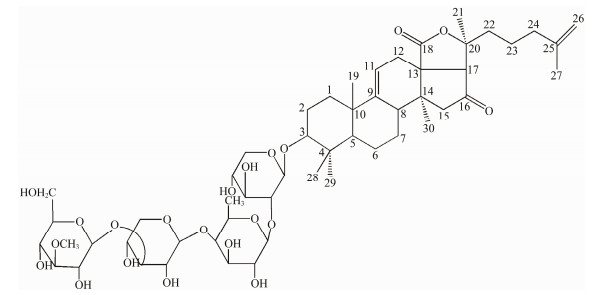
|
Fig. 1 The structure of cladoloside A (CA). |
In the study, ethanol was selected for the extraction of saponins in A. japonicus. The optimal concentration of ethanol was investigated by comparing the effects of different concentrations in the range of 60%–90% (v/v). From Fig.2, 70% (v/v) ethanol was the best extraction solvent. As the maximum volume of the microwave extraction vessel was 30 mL, in order to acquire the best extraction efficiency, the 70% ethanol volumes in the range of 10–30 mL were further investigated, as shown in Fig.3. When the extraction volume was 25 mL, the yield of CA was the highest.
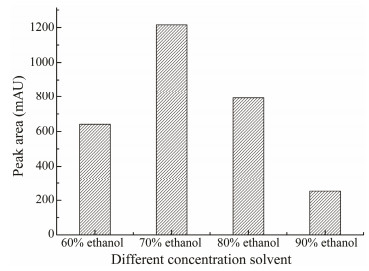
|
Fig. 2 The effects of different concentrations of ethanol (60%–90%) on the extraction yields of CA. |
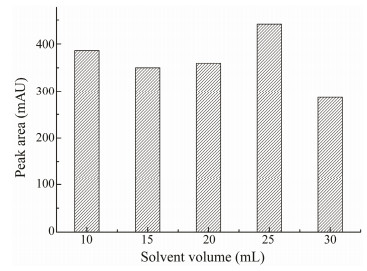
|
Fig. 3 The effects of different extraction solvent volumes (10–30 mL) on the extraction yields of CA. |
To monitor the effect of irradiation time, samples were extracted with 70% (v/v) ethanol for 5, 10, 15, 20, and 25 min. As shown in Fig.4, the maximum extraction yield was obtained at 10 min and set as the optimal time for MAE. The temperature was also an important factor in MAE. We optimized the temperature by performing extractions at 35, 45, 55, 65, 75, and 85℃. As shown in Fig.5, in the beginning, when the heating temperatures were set from 35℃ to 45℃, the extraction rate of CA increased as well. When the temperature rose to 55℃, the CA yield started to decrease. At a higher temperature, the solvent could be rapidly absorbed by the cellular matrix, which can cause cell wall rupture quickly, increasing the release of components into the solvent, causing a higher extraction rate. In comparison, as the temperature exceeds a certain point, it will cause the degradation of thermolabile compounds. Thus, the contents of CA might decrease if the temperature is too high. Considering the results, 45℃ was the best heating condition for extraction.
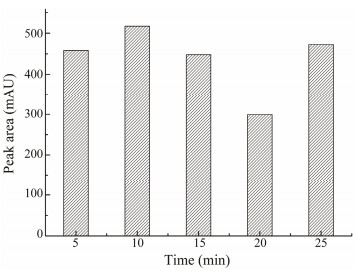
|
Fig. 4 The effects of different extraction times (5–25 min) on the extraction yield of CA. |
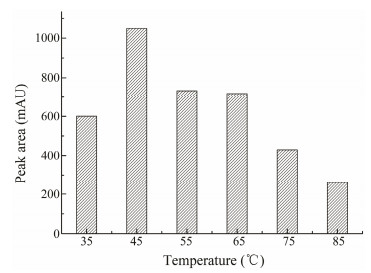
|
Fig. 5 The effects of different irradiation temperatures (35–85℃) on the extraction yield of CA. |
Finally, the effect of microwave power on extraction efficiency was also investigated. The microwave power was set to 400, 800, and 1600 W. With the same conditions, it can be clearly observed that the sample was destroyed when microwave power was set to 800 or 1600 W. This is because the higher microwave power increases the temperature inside the microwave, which may result in the destruction of cells, eventually reducing the yield. Thus, the microwave power of 400 W was selected as the optimal condition.
3.3 Method ValidationsFig.6 shows the chromatographic separation result of CA by HPLC-DAD. Good linearity of the CA was obtained in a relatively wide concentration. The correlation coefficient was 0.9990, and the standard calibration curve equation was Y = 1264X + 2.917. The inter-day and intra-day precision rates were 2.5% and 3.2%, respectively. The LOD and LOQ were 0.0015 and 0.005 mg mL−1, respectively.
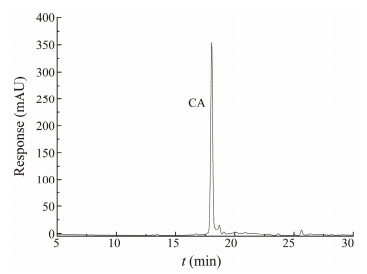
|
Fig. 6 The HPLC-DAD chromatogram of CA. |
Three level spiked samples (10, 20, and 50 μg g−1) were selected for continuous injection five times. The average recovery rates were 90.1%, 92.2%, and 104%, and the precision rates were 4.5%, 2.3%, and 2.5%, respectively, for the three samples. The verification results showed that the developed method could provide good accuracy and high sensitivity for CA analysis.
3.4 Application of the Developed MethodTo determine the CA, the described method was applied on different tissues of A. japonicus. The analytical results are shown in Table 2. As can be observed from Table 2, the concentration of the CA was the highest in parapodium. The concentration sequence of the CA was as follows: parapodium > muscle > body wall > viscera > coelomic fluid. Sea cucumber saponins are generally considered as a chemical defense against predators, the distribution of which may relate to defensiveness (Magali et al., 2015). According to the previous studies (Van et al., 2011; Magali et al., 2015), sea cucumber may release saponins into the seawater from the skin or from interior organs when subjected to stress. This phenomenon may explain why CA has different concentrations in different parts of the body. CA is a non-sulfate saponin with poor water solubility and low toxicity. The saponins could slowly diffuse into the water due to the absence of sulfate and hydroxyl groups; thus, they take longer to reach the predator (Magali et al., 2015). When parapodium is exposed outside the skin, the concentrations may be higher.
|
|
Table 2 CA concentrations in different parts of A. japonicus |
The contents of CA in the sea cucumber from different harvesting seasons were determined using the described method. The CA concentrations were 46.3 μg g−1 in April and 22.5 μg g−1 in November. From the data, we can see that the CA content was higher in April.
In a summery, the saponin CA was first extracted from A. japonicus in this study. Column chromatography was performed for the purification of the compounds from 80% ethanol extract. The structure was identified based on spectroscopic methods and literature references. CA has been isolated from the Vietnamese sea cucumber Cladolabes schmeltzii in 2014 (Alexandra et al., 2014). Alexandra et al. (2014) studied the cytotoxic activity of CA on mouse spleen cells and hemolytic activity on mouse red blood cells, and the results showed strong cytotoxicity and hemolysis. Whether CA isolated from A. japonicus has the same function needs further study in the near future.
4 ConclusionsIn this study, a rapid and simple method based on MAE followed by HPLC-DAD was performed for the first time for the quantitative determination of CA in A. japonicus samples. MAE, with relative high extraction efficiency, reduced extraction solvent and short sample preparation time was found to be a suitable technique to extract saponins from A. japonicus for quantitative determination. The optimal MAE conditions were as follows: extraction time of 10 min, temperature of 45℃, and solvent volume of 25 mL 70% ethanol under 400 W. In addition, low limits of determination and quantification, precision, and satisfactory recoveries were obtained with the proposed method. The proposed method was successfully applied to analyze the saponin CA in different tissues of A. japonicus. The study of the proposed method provided quantitative technical support for the quality control of A. japonicus. Furthermore, it could be an auxiliary analysis method for elucidating the molecular mechanism of pharmacological effects of saponins.
AcknowledgementsThis study was supported by the National Key R & D Program of China (No. 2018YFD0900105), the Entrepreneurship Program for High-Level Talent of Dalian (No. 2018RD10), the Liaoning Revitalization Talents Program (No. XLYC1907109), and the Liaoning Key Research and Development Program (No. 2018228004).
Alexandra, S. S., Anatoly, I. K., Sergey, A. A., Pelageya, V. A., Pavel, S. D., Ekaterina, A. Y., et al.. 2014. Triterpene glycosides from the sea cucumber Cladolabes schmeltzii. Ⅱ. Structure and biological action of cladolosides A1–A6. Natural Product Communications, 9(10): 1421-1428. (  0) 0) |
Avilov, S. A., and Stonik, V. A.. 1988. New triterpenen glycosides from the holothurian Cladolabes sp. Chemistry of Natural Compounds, 24(5): 656. DOI:10.1007/BF00633413 (  0) 0) |
Ganzler, K., Salgó, A., and Valkó, K.. 1986. Microwave extraction, a novel sample preparation method for chromatography. Journal of Chromatography A, 371: 299-306. DOI:10.1016/S0021-9673(01)94714-4 (  0) 0) |
Gao, Z. Y., Wang, R., Guo, F. J., Jia, Q., and Li, Y. M.. 2014. Determination total saponin content in sea cucumbers. Chinese Journal of Experimental Traditional Medical Formulae, 20(15): 89-92 (in Chinese with English abstract). (  0) 0) |
Guillaume, C., Karim, M., Dina, L. S., Corentin, D., Marie, D., Igor, E., et al.. 2016. Chemical characterization of saponins contained in the body wall and the Cuvierian tubules of the sea cucumber Holothuria (Platyperona) sanctori (Delle Chiaje, 1823). Biochemical Systematics and Ecology, 68: 119-127. DOI:10.1016/j.bse.2016.06.005 (  0) 0) |
Guo, S. S., Yang, L. M., Zhang, Y. M., Yang, L., and Han, M.. 2015. Determination of contents of total saponins and monomer saponins in Panax ginseng by micro-assisted extraction method. Food Chemistry, 36(2): 1-6. DOI:10.1007/s11783-011-0280-z (  0) 0) |
Liu, H. L., Kong, X., Chen, J. W., and Zhang, H. B.. 2018. De novo sequencing and transcriptome analysis of Stichopus horrens to reveal genes related to biosynthesis of triterpenoids. Aquaculture, 491: 358-367. DOI:10.1016/j.aquaculture.01.012 (  0) 0) |
Magali, H. E., Roberto, A. E., Francisco, A. S., and Yves, S.. 2015. Biological and taxonomic perspective of triterpenoid glycosides of sea cucumbers of the family Holothuriidae (Echinodermata, Holothuroidea). Comparative Biochemistry and Physiology, Part B, 180: 16-39. DOI:10.1016/j.cbpb.2014.09.007 (  0) 0) |
Menchinskaya, E. S., Pislyagin, E. A., Kovalchyk, S. N., Davydova, V. N., Silchenko, A. S., Avilov, S. A., et al.. 2013. Antitumor activity of cucumarioside A2-2. Chemotherapy, 59: 181-191. DOI:10.1159/000354156 (  0) 0) |
Menéndez, J., Arenillas, A., Fidalgo, B., Fernández, Y., Zubizarreta, L., Calvo, E. G., et al.. 2010. Microwave heating processes involving carbon materials. Fuel Processing Technology, 91: 1-8. DOI:10.1016/j.fuproc.2009.08.021 (  0) 0) |
Van, D. S., Caulier, G., Todesco, M., Gerbaux, P., Fournier, I., Wisztorski, M., et al.. 2011. The triterpenoid glycosides of Holothuria forskali, usefulness and efficiency as achemical defense mechanism against predatory fish. Journal of Experimental Biology, 214: 1347-1356. DOI:10.1242/jeb.050930 (  0) 0) |
Xu, C., Zhang, R., and Wen, Z. Z.. 2018. Bioactive compounds and biological functions of sea cucumbers as potential functional foods. Journal of Functional Foods, 49: 73-84. DOI:10.1016/j.jff.2018.08.009 (  0) 0) |
Xue, C. H., Yu, L. F., Dong, P., Xu, J., Li, Z. J., and Xue, Y.. 2010. Isolation and identification of three triterpene glycosides from sea cucumber Apostichopus japonicus Selenka of Qingdao. Periodical of Ocean University of China, 40(8): 60-65 (in Chinese with English abstract). (  0) 0) |
Yu, S., Gao, J., Hao, J. W., and He, T. T.. 2016. Study on ultrasonic-assisted extraction of Pulsatilla chinensis total saponin by response surface methodology. Hubei Agricultural Sciences, 55(20): 5348-5351 (in Chinese with English abstract). (  0) 0) |
Yu, S. R., Ye, X. W., Huang, H. C., Peng, R., Su, Z. H., Lian, X. Y., et al.. 2015. Bioactive sulfated saponins from sea cucumber Holothuria moebii. Planta Medica, 81: 152-159. DOI:10.1055/s-0034-1383404 (  0) 0) |
Zhang, R., Wang, Y. H., Liu, Y. F., Yang, J., Jiang, T. F., and Lv, Z. H.. 2013. Isolation, preparation and analysis of triterpene glycoside Holotoxin A1 in Apostichopus japonicus. Chinese Journal of Marine Drugs, 4(8): 8-14 (in Chinese with English abstract). (  0) 0) |
Zhang, Y., Li, H. J., Dou, H. T., He, Z. F., Wu, H. J., Sun, Z. G., et al.. 2013. Optimization of nobiletin extraction assisted by microwave from orange byproduct using response surface methodology. Food Science and Biotechnology, 22: 153-159. DOI:10.1007/s10068-013-0061-5 (  0) 0) |
 2022, Vol. 21
2022, Vol. 21


